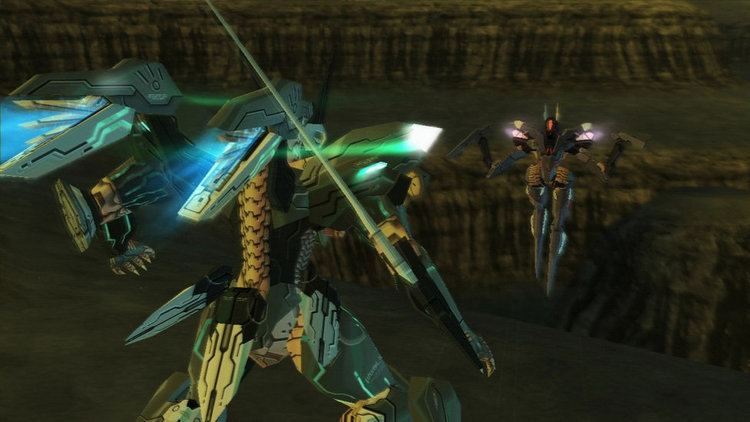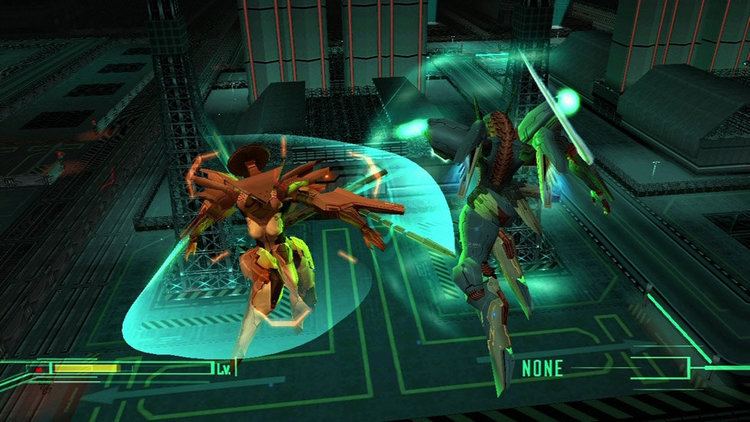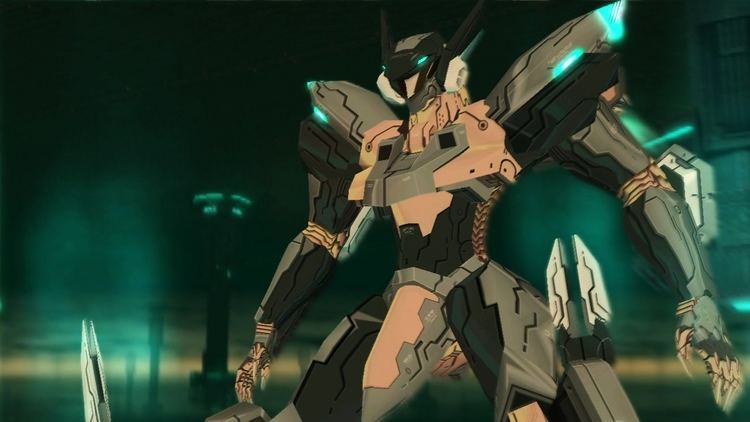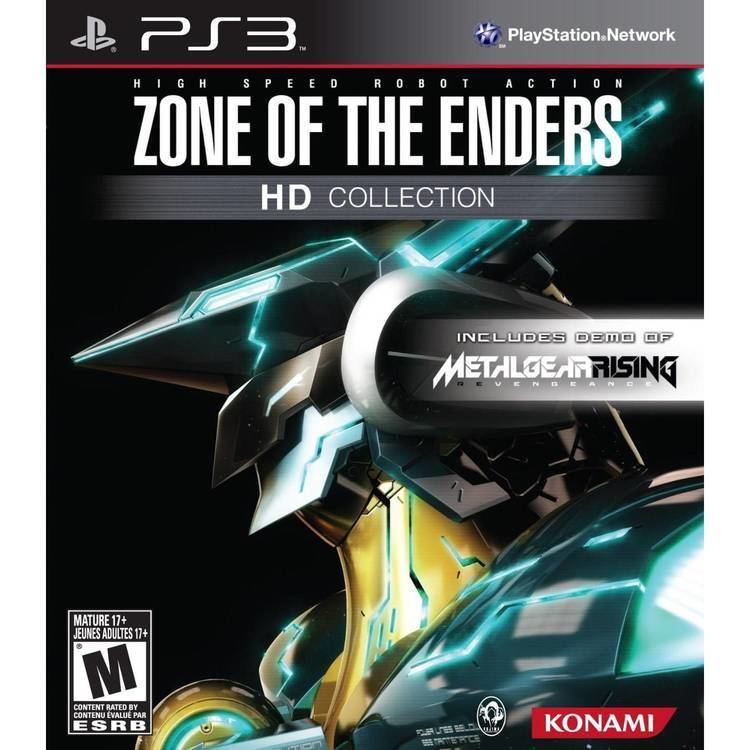Initial release date 1 March 2001 | Director(s) Noriaki Okamura Artist(s) Nobuyoshi Nishimura Series Zone of the Enders | |
 | ||
Writer(s) Noriaki OkamuraShuyo Murata Composer(s) Maki KiriokaAkihiro HondaNorihiko HibinoToshiyuki KakutaShuichi Kobori Genres Hack and slash, Third-person shooter Developers Konami, High Voltage Software, Konami Computer Entertainment Japan Similar Hideo Kojima games, Shooter games | ||
Zone of the Enders (ZONE OF THE ENDERS Z.O.E ゾーン オブ エンダーズ, Zōn obu Endāzu), officially abbreviated as Z.O.E, is a hack and slash and third-person shooter video game that was developed and published by Konami for the PlayStation 2. It was released on March 1, 2001 in Japan and later in the same month for both North America and Europe. The game is based around mecha combat with the player controlling the "Orbital Frame" Jehuty. Across the game, the player has to protect towns from enemies and obtains new weapons.
Contents

The plot is set in the space around Jupiter and follows a young colonist named Leo Stenbuck who is one of the few survivors from his colony after it was attacked by the military force BAHRAM. Surviving using Jehuty, Leo is on a mission to return Jehuty to the Space Force and uses the Frame to protect civilians. The game was created with the intention of having a more serious and realistic focus on the mecha genre. The mechas were designed by Yoji Shinkawa, the character and mechanical designer for the Metal Gear series. The music was composed with the idea of fitting the game's atmosphere.

Critical reaction to Zone of the Enders has been positive. While the combat and the graphics have been generally well received, its short length and poor localization have been the most common areas of criticism. The game spawned two follow-ups including a spin-off for the Game Boy Advance and a direct sequel for the PlayStation 2. The Japanese animation studio Sunrise also produced two works related to Zone of the Enders. The game was re-released alongside its direct sequel Zone of the Enders: The 2nd Runner for PlayStation 3 and Xbox 360 in October 2012 as part of the Zone of the Enders HD Collection.

Gameplay

Zone of the Enders is a hack and slash and third-person shooter game in which the player controls the advanced mecha, or Frame, known as Jehuty. Jehuty is capable of three-dimensional movement, flying and hovering above the ground with ease. Jehuty traverses across different areas of a space colony orbiting Jupiter to defeat rogue Orbital Frames, using its advanced weaponry. In some stages, there is also the objective of minimizing damage to nearby buildings and civilians resulting in more strategic combat although the player is not forced to protect the civilians in order to progress. In order to restore Jehuty's health an item known as Metatron Ore can be found and used in every area.

In battle, Jehuty locks-on to a single enemy Frame and is able to perform advanced maneuvers such as grabbing and throwing enemies, deploying an energy shield, and using booster jets to move quickly and dodge enemy attacks. It is equipped with an energy sword, an energy projectile, and various sub-weapons. As the player progresses, Jehuty's arsenal grows and its abilities expand by obtaining programmes alongside their respective code. Every time Jehuty defeats an enemy it gains experience. After gaining a determined amount of experience it levels up, improving most of its qualities.
Once completing the game, a Versus Mode is unlocked. The player can use it to compete with the artificial intelligence (AI) or another player while controlling two Frames.
Plot
The game takes place exactly 5 years after the events of ZOE: 2167 IDOLO, in the year 2172. When mankind has colonized Earth's moon, Mars and Jupiter's moons. A military force known as BAHRAM sends its primary offensive unit to attack Jupiter colony Antilia in order to secure two advanced machines known as Orbital Frames. One of the few colony survivors, a young boy named Leo Stenbuck, sees his friends being killed by a falling LEV. He flees to a hangar, where he finds an Orbital Frame by the name of Jehuty. Using this suit and its built-in AI A.D.A, he fends off the BAHRAM forces led by officer Viola who seek to claim Jehuty on the orders of their leader Nohman. Leo is then contacted by the commander of the civilian transport vessel Atlantis, Elena Weinberg, who belongs to Earth's military forces, the United Nations Space Force. As Jehuty's original pilot died during the attack, Elena requests Leo's assistance to deliver Jehuty back to them as they need to take it to Mars. Leo reluctantly accepts to protect other survivors but he refuses to kill his enemies.
Battling through Antilia, Leo often clashes with ADA as he is against killing enemies while ADA tends to tell him killing enemies is necessary to survive. He ends rescuing civilians, including his friend Celvice Klein, and defends the colony from destruction, defeating the BAHRAM forces and their commanders one by one. Before reaching Atlantis, Leo encounters Viola who seeks a rematch. Although Leo defeats Viola, he is unwilling to kill her. Later, Atlantis pilot Rock Thunderheart meets Leo in person and reveals that the BAHRAM forces are still determined to obtain Jehuty and are threatening with destroying the colony. Thunderheart requests Leo's help to pilot Jehuty once again as he has realized his skills are superior. It is then that Viola shoots Celvice to force Leo to fight again. Celvice is taken to the Thunderheart to be treated while Leo goes to save the colony.
Leo goes to the docks to disarm the explosives placed there to destroy the colony. Viola battles him once more, but is defeated and killed when a leftover bomb blows her out of the colony and into Jupiter's atmosphere. Nohman himself then appears in Jehuty's twin Frame Anubis, that was captured by BAHRAM. Anubis' power and speed overwhelm Jehuty forcing Leo to search for a way to escape. Before Nohman can destroy Jehuty, Atlantis blows a hole in the wall and covers Jehuty's escape. As Jehuty is docking, ADA reveals to Leo her programming: when taken to the fortress Aumaan on Mars, she is to eject her pilot and self-destruct Jehuty, destroying the frame and the fortress. Saddened by this, Leo leaves Jehuty's cockpit and meets up with the crew of the Atlantis and Celvice, who survived her gunshot wound.
Development
Zone of the Enders started development for the PlayStation and PC but the Konami staff had no intentions of releasing them for those platforms. The game was created with the intention of an anime-style robot with a focus on realism rather than what other sci-fi series do. The staff was assisted by people who had scientific research for other anime series. Director and scenario writer Noriaki Okamura wanted to write a serious story where people have complicated lives. The main theme is "What is life? What is living all about?" as reflected in Leo's hardships across the plot. Because of the message he wanted to convey, multiple endings were avoided although sidequests can still have multiple results. Nevertheless, two other endings can be unlocked depending on the player's performance when protecting civilians. In contrast to other 3D games, the team worked to give players the sensation that they are controlling a fast robot which resulted in a year of work on the camera.
Okamura worked in Zone of the Enders with the objective of telling a story through non story-sequences of the game. In order to do this, the staff focused on adding several details such as the destroyed buildings which would explain the player's objectives. Character designer Nobuyoshi Nishimura expressed difficulties in designing the cast as they were supposed to fit the mechas and the 3D models. In order to take advantage of the 3D design, Nishimura tried moving the camera as often as possible. He tried not to "go overboard" during cutscenes to emphasize the appeal of the mechas during gameplay. During development of the game, the team was assisted by producer Hideo Kojima whom Okamura appreciated due to how he helped them.
Yoji Shinkawa was in charge of designing the game's mechas, the Orbital Frames. He worked in making them look "cool" and also how they would move depending on the player's actions. He thought about giving the Frames their own transformations but instead found Jehuty flying and skating to be enjoyable. As a joke, Shinkawa designed the cockpit in the Frames' crotch region. The staff first had the idea of naming a Frame Anubis based on Egyptian mythology which resulted in the main Frame being named Jehuty. The Frame LEV was supposed to appear during the gameplay as weak Frames that would try to shoot Jehuty and the Raptors and could be easily be defeated. However, they ended appearing only during cutscenes.
Zone of the Enders was originally planned to be released in Japan on February 1, 2001 but it was delayed to March 1, 2001. The premium package in the Japanese edition contains an original video animation (OVA) titled ZOE: 2167 IDOLO produced by Sunrise and is set five years before the events on the game. Okamura was satisfied with Sunrise's work noting how they were experienced producing robot anime. During the game and OVA's production, Shinkawa submitted a design of the titular Frame, IDOLO, to make it fit the Frames from the video game. The English versions were released on March 23, 2001 in Europe and March 27, 2001 in North America. They were originally sold packaged with a preview demo of the then-upcoming Metal Gear Solid 2: Sons of Liberty.
Music
The game's soundtrack was released in Japan on April 25, 2001 by Konami Music Entertainment. The soundtrack uses a technopop-based sound, as recommended by producer Hideo Kojima. According to director Okamura, the music is calm during normal situations and when facing enemies new tracks are added. When the player faces complicated situations there is also a change in the audio as he and the team wanted it to "convey emotions." Almost all the music was composed by Norihiko Hibino, Maki Kirioka, and Akihiro Honda. The main theme, "Kiss Me Sunlights", was composed and performed by Heart of Air. Some of the game's music was later included in Metal Gear Online.
Reception and legacy
Zone of the Enders received generally positive response currently having an average of a 78 out of 100 in Metacritic. On release, Famitsu magazine scored the PlayStation 2 version of the game a 31 out of 40. Praise has often been aimed to the game's fight system which is benefitted by its 3D camera and Jehuty's fast movements. David Smith from IGN came to regard it as one of the best mecha games he has ever played. The combat has been found to lack difficulty due to the enemies' AI, lack of variety, and all the options the player is given to fight. Additionally, the game has been found too short with the harder difficulties not giving a better challenge. However, the versus mode was better received with Shane Satterfield from GameSpot due to its competition value and how "it accentuates ZOE's finest trait". As a result of the issues, while Shawn Sanders found the game was "a better rental than purchase," its Metal Gear Solid 2: Sons of Liberty demo made the game worth buying.
The visual design has also been praised for the amount of detail the areas and Jehuty were given, the appropriate framerate to the point Arnold Katalev from PSXExtreme favorably compared it with Onimusha: Warlords, a recently released game that employed appealing graphics. Despite the generally positive comments on the gameplay and design, the presentation has been a major area of criticism. The game's localization was a major concern with the English voice acting having been referred as "emotionless" by Smith while the script was noted to have the flaw of repeating the same words too many times. Although Smith found some English actors tolerable, he was annoyed by Leo's English voice as it made the character unlikable. The story's open ended ending made Gaming Age writer Patrick Klepek wonder if Konami rushed the game and hoped the company had instead worked more in the game to expand its length and fill missing plot elements.
During 2001, it was the 81st bestselling game in Japan with a total of 120,658 units sold. The game's sales in North America were noted to have been favored by the demo of Metal Gear Solid 2 as several fans bought it to try the demo. It was the sixth best selling game in North America during March 2001.
In June 2001, Konami announced a spin-off game titled Zone of the Enders: The Fist of Mars for the Game Boy Advance with Sunrise Interactive developing it. Sunrise also produced an animated television series titled Z.O.E. Dolores,i in 2001. Although there were no plans for a sequel to the original game, in May 2002 Konami announced one titled Zone of the Enders: The 2nd Runner for the PlayStation 2 and was released in 2003. For The 2nd Runner, Konami published an intersequel that follows Leo's activities with Atlantis as well as his growth as a pilot. Zone of the Enders was ported to the Xbox 360 and PlayStation 3 alongside The 2nd Runner. A sequel to 2nd Runner was announced in May 2012 as "The Enders Project" but was cancelled a year later due to issues with the HD ports.
